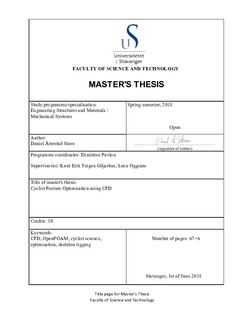| dc.contributor.advisor | Giljarhus, Knut Erik Teigen | |
| dc.contributor.author | Stave, Daniel Årrestad | |
| dc.date.accessioned | 2018-09-14T07:14:42Z | |
| dc.date.available | 2018-09-14T07:14:42Z | |
| dc.date.issued | 2018-06 | |
| dc.identifier.uri | http://hdl.handle.net/11250/2562590 | |
| dc.description | Master's thesis in Mechanical engineering | nb_NO |
| dc.description.abstract | A procedure for optimising the posture of a cyclist concerning the drag force predicted by computational fluid dynamics is developed and executed using open-source software only. The computational setup is validated by testing it on simpler geometry, a sphere, for which extensive experimental studies are available for, and results confirmed to have good agreement with experimental studies performed by Achenbach (1972,1974). Five 3D scanned postures of the Team Sky athlete Tao Geoghegan Hart are simulated, and by comparing the drag force of the present result with similar models simulated in the literature, the drag force of the present results are confirmed to be realistic. The relative change in drag of the postures is confirmed to agree with simulations of the same postures using commercial software. The optimisation procedure is based on a single 3D scanning of a given cyclist, which is modified using skeleton rigging. Hence, for the first time, skeleton rigging is utilised to study the optimal posture of a cyclist. The modifications of the cyclist posture are limited to the distance between elbows, elbow extension and distance between hands, and the boundaries of the modifications are defined in such a way that all the resulting postures satisfy the corresponding regulations by International Cycling Union. Simulation results show that a small distance between elbows, minimum elbow extension and any distance between hands, is the favourable combination for reducing the drag force. The elbow extension seems to be the most crucial parameter, secondly the distance between elbows, and then, the distance between the hands. Additionally, a cyclist posture which experiences a small drag force is also characterised by a narrow wake, a small frontal area and a streamlined flow. A regression model is constructed based on the simulation results of optimisation. This regression model did not reveal any new local minimums compared to the simulation results, yet, proved itself useful when analysing the trends of between posture and drag. | nb_NO |
| dc.language.iso | eng | nb_NO |
| dc.publisher | University of Stavanger, Norway | nb_NO |
| dc.relation.ispartofseries | Masteroppgave/UIS-TN-IMBM/2018 | |
| dc.rights | Navngivelse 4.0 Internasjonal | * |
| dc.rights.uri | http://creativecommons.org/licenses/by/4.0/deed.no | * |
| dc.subject | maskinteknikk | nb_NO |
| dc.subject | maskinkonstruksjon | nb_NO |
| dc.subject | sykling | nb_NO |
| dc.subject | optimisation | nb_NO |
| dc.subject | skeleton rigging | nb_NO |
| dc.title | Cyclist Posture Optimisation using CFD | nb_NO |
| dc.type | Master thesis | nb_NO |
| dc.description.version | submittedVersion | nb_NO |
| dc.subject.nsi | VDP::Teknologi: 500::Maskinfag: 570::Maskinkonstruksjon og materialteknologi: 571 | nb_NO |
| dc.source.pagenumber | 83 | nb_NO |

